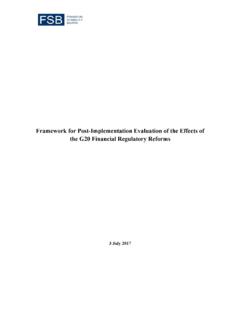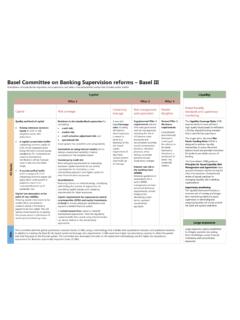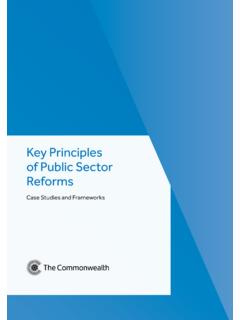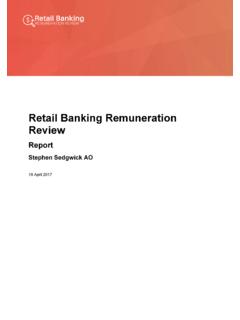Transcription of Towards a Palestinian State: Reforms for Fiscal Strengthening
1 Towards a Palestinian State: Reforms for Fiscal Strengthening Economic Monitoring Report to the Ad Hoc Liaison Committee April 13, 2010. The World Bank Contents Acronyms .. 3. Executive Summary .. 4. Introduction .. 6. Potential for Economic Revival .. 8. Easing of Economic Restrictions .. 8. Recent Economic Developments .. 9. The PA Fiscal Position .. 13. Improving Public Finance Management .. 15. Public Procurement .. 16. Strengthening the Fiscal Position .. 18. Social Safety Net .. 18. Public Pension System .. 19. Electricity Distribution and Net Lending .. 20. Municipalities: Contribution to Service Delivery and Fiscal Impact .. 23. Concluding 29. References .. 30. List of Figures Figure 1: Economic growth 2001-2009 .. 9. Figure 2: Unemployment rates, 1995 -- second quarter 13. Figure 3: Percentage of municipalities providing a given service .. 25. List of Tables Table 1: Gaza -- Status of key industrial sectors during three periods .. 11. Table 2: Classification of local government units.
2 23. Table 3: Historical overview of the Palestinian local government system .. 24. Table 4: Revenue sources of local government units .. 26. 2. Acronyms AHLC Ad Hoc Liaison Committee EU European Union GDP Gross Domestic Product GEDCO Gaza Electricity Distribution Company GoI Government of Israel HEDCO Hebron Electricity Distribution Company ICBS Israeli Central Bureau of Statistics IEC Israel Electricity Company IMF International Monetary Fund IPSAS International Public Sector Accounting Standards JDECO Jerusalem District Electricity Company JSC Joint Services Council LGU Local government unit MDLF Municipal Development Lending Fund MENA Middle East and North Africa MoF Ministry of Finance MoLG Ministry of Local Government MoSA Ministry of Social Affairs NEDCO Northern Electricity Distribution Company NGO Non-governmental organization NIS New Israeli Shekels PA Palestinian Authority PalTrade Palestine Trade Center PCBS Palestinian Central Bureau of Statistics PFM Public financial management PNCTP Palestinian National Cash Transfer Program PRDP Palestinian reform and Development Plan SAACB State Audit and Administrative
3 Control Bureau SELCO Southern Electricity Company SHC Special Hardship Case SSNRP Social Safety Net reform Project UNRWA United Nations Relief and Works Agency for Palestine Refugees in the Near East UPL Unified Pension Law WB&G West Bank and Gaza 3. Executive Summary a. A viable state requires public institutions that create an enabling environment for private sector-driven growth, manage public finances efficiently, and are able to deliver effective services to the population. The Palestinian Authority (PA) is making steady progress on implementing its reform program and building the institutions required by a future state: the PA has strengthened its public financial management systems, improved service delivery, and made significant Reforms to increase security and shore up its Fiscal position. However, only a dynamic private sector can generate the jobs required by a young and growing population and furnish the resources needed to provide basic services to citizens. While recent economic resurgence is a cause for optimism - with Gross Domestic Product (GDP) growth in 2009.
4 Reaching about percent coming on top of nearly 6 percent in 2008 the situation remains precarious. Most growth is in the West Bank, while Gaza continues to experience falling per capita GDP. Furthermore, growth is driven by a combination of large inflows of donor assistance, PA government Reforms that have increased investor confidence, and the loosening of some Israeli security restrictions. Sustainability of the growth, given the reliance on donor assistance, is a cause for concern. b. Sustained private sector growth requires a shift from public sector-driven investment to a real takeoff in private sector investment. Part of this can be achieved by the PA continuing and accelerating its Reforms . However, the largest impediment to private sector investment in the West Bank and Gaza remains the restrictions on movement and access to resources and markets imposed by the Government of Israel (GoI). Sustained growth is dependent on the GoI further easing restrictions it has already taken loosened - particularly through increased Palestinian access to the land and resources in Area C, access to markets in East Jerusalem and Israel, and by creating a higher level of predictability on movement and access.
5 C. The PA will continue to be dependent upon donor financing of its operating budget for some time to come, while it implements an ambitious reform agenda. The international community should commit to continuing to support this agenda including through more predictable flows of financing. In 2009 the PA's recurrent budget deficit rose to nearly US$ billion compared to US$ billion in 2008. This was mostly due to the need to respond to the emergency situation in Gaza. The PA recognizes that it cannot sustain such a high deficit and that while donor funding has been generous it will not remain at such a high level. The 2010. budget commits the PA to reducing its recurrent deficit to about US$ billion while also increasing development expenditures to US$670 million. Nearly US$350 million of these expenditures will be committed to community development projects that are a central part of the PA's strategy to spur development and meet the needs of the population. The PA reports that it has already completed 1,000 of these demand driven projects and aims to complete another 1,000.
6 By the end of 2010. Lack of predictability in external financing jeopardizes the ability of the PA. to efficiently manage its expenditures and thus consolidate the gains made to date. d. Critical elements of the PA's reform and institutional development agenda focus on improving public financial management and Strengthening its Fiscal position. The Ministry of Finance (MoF) continues to steadily improve its public financial management system. It has 4. linked all ministries to the new computerized accounting system, closed non-zero balance bank accounts, and introduced new methods of commitment control. The 2008 financial statements have been compiled and submitted to the external auditor. Public procurement remains an important issue that the Government is pursuing with a new law drafted but not yet adopted. The PA plans to refine the current draft and adopt it in 2010, which will allow the establishment of a new public procurement system based on international best practice. e. For Fiscal Strengthening , the PA is concentrating on pensions, net lending, electricity distribution and municipal finances, which have substantial effects on the budget.
7 The PA. has committed to reform the public pension system and is currently working on a plan to move forward, but the pace of reform needs to be stepped up. On net lending the results are encouraging -- the PA was successful in reducing net lending by over 30 percent between 2007. and 2009 and some 80 percent of the remaining sum was in Gaza, where the PA has little ability to take action. On electricity there is some progress -- a new electricity regulator is operational and the systems for the Northern Electricity Distribution Company are being established. However, more sustained efforts are needed to effectively tackle this issue in the West Bank by transferring electricity distribution from local governments to commercially run distribution companies, as required by the Electricity Law. f. The Reforms of the electricity distribution system are interwoven with the broader agenda of municipal finances. In a highly decentralized system, local government units are responsible for delivering extensive services and have a large impact on the PA's Fiscal position though net lending and other transfers.
8 Thus, improving the Fiscal sustainability and efficiency of service delivery of local government units is a priority. In addressing the net lending issue, the PA has analyzed local governments' Fiscal operations and is developing plans to address identified constraints. Important steps, such as increasing and extending property tax collections and creating incentives to improve accounting systems, have been taken. In the longer term, the PA plans to address the inefficiency of the large number of small government units by moving to a more viable structure. g. By many measures the PA is well on the way to delivering on its promise to create a Palestinian state that can deliver services and economic prosperity to its population. Nonetheless, this is not the time for complacency. Concerted action on creating the enabling environment for private sector growth is needed. This implies continued easing of movement and access restrictions by GoI, perseverance on the reform agenda by the PA, and sustained and predictable support by the international community.
9 This period represents an opportunity for all parties Palestinians, Israel, and the international community -- to rise to the challenge and ensure that the underpinnings of the future state are as solid as they can be. 5. Introduction 1. The 13th Government of the PA presented in August 2009 a program entitled Palestine: Ending the Occupation, Establishing the State (hereafter referred to as the Program) that lays out the vision, foundational principles, and national goals for the future Palestinian state, as well as institution-building and sector priorities. The sector priorities are presented in four broad themes governance, social, economy, and infrastructure and ensuing policies and programs are classified by the implementing ministries and non-ministerial agencies 1. Furthermore, Prime Minister Salam Fayyad announced in the March 25, 2010 Local Development Forum meeting his Government's intention to present another document by the summer of 2010 outlining the priorities for the last year prior to the declaration of the state in 2011.
10 2. Arguably, one of the most critical current reform areas for the PA is Strengthening its Fiscal position in order to achieve Fiscal sustainability for the future state. Reforms revolving around Fiscal Strengthening and improved public financial management are listed in the Program as priorities and have been high on the PA's reform agenda for some time now -- they were also salient in the PA's Palestinian reform and Development Plan (PRDP) for 2008-2010. Some of the main Reforms that aim to strengthen the PA's Fiscal position involve the social safety net, pension system, and electricity distribution and net lending 2. Another set of related Reforms aims to increase the efficiency and transparency of government expenditures, in and of itself important but also serving to raise the confidence of donors in the PA's financial systems and facilitating untied budget support. Reforms in public financial management and public procurement are particularly important in this context. This report will therefore provide some background and an update on the progress to date in the implementation of these key reform areas.


















